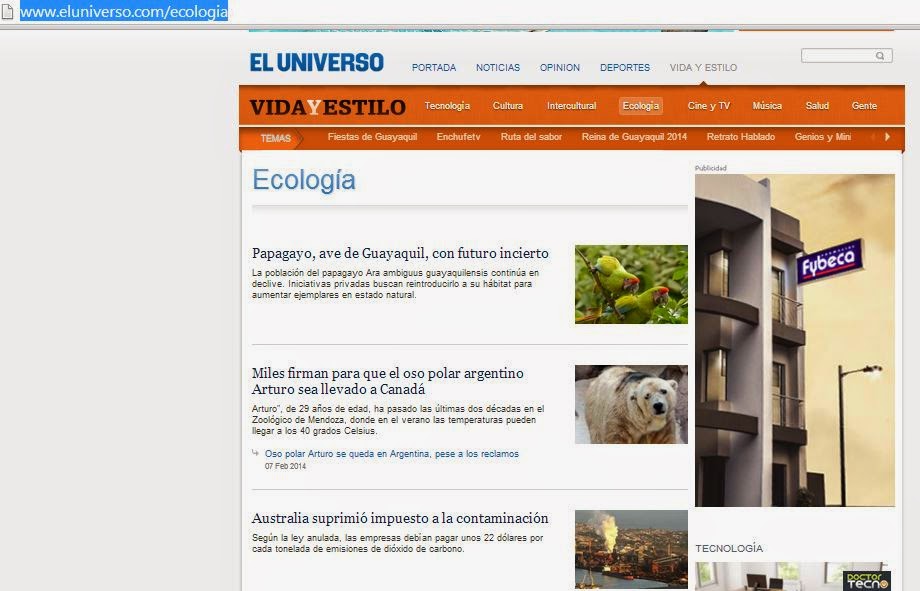El Universo, Sunday, July 20, 2014
With a ´national conservation strategy´ and having been declared by a
municipal ordinance the natural symbol of the city has not permitted
maintaining or improving the population in its natural state of the Guayaquil
Macaw (Ara ambiguus guayaquilensis),
in critical danger of extinction and that tomorrow, July 21st is
commemorated as the Day of the Guayaquil Macaw.
This subspecies of the great green macaw (Ara ambiguus) is distinguished by its brilliant green plumage and
in its wings light up with turquoise blue that at the tail mixes with
orange. Before the beak begins to
curve, a red crest projects out.
In 2005, the year that the ´in situ (in its natural habitat)
Guayaquil Macaw´ National Conservation Strategy was released and updated and changed to ´Great
Green Macaw National Conservation Strategy´ in 2009 as well as municipal
council ordinance were expedited as protection measures, the Ecuadorian
population of this rare bird was estimated at between 60 and 90 individuals or
20 to 30 pairs in the natural state.
Eric Horstman, executive director of the Pro-Forest Foundation,
institution situated in the Cerro Blanco Protected Forest and has diverse
programs and actions to guarantee the future of the bird, estimates that now
there are between 40 and 50 individuals remaining in the wild.
The dry forest of the Cordillera Chongon Colonche and the humid forest
of Esmeraldas Province are the two principal habitats of this species, but they
are in danger because of deforestation and hunting.
In captivity survive 53 individuals, the product of confiscations, and voluntarily
handing over macaws to wildlife rescue centers and zoos in the country. They are distributed in ample cages in Cerro
Blanco, the Guayaquil Historic Park and the Jambeli Rescue Foundation Center,
that has worked since 1996 in the ex situ
(outside of its habitat) conservation and captive reproduction of the bird.
This measure according to Joaquin Orrantia Vernaza, Director of Jambeli
Rescue is a viable alternative for the recuperation of endangered species such
as the Guayaquil Macaw. Captive reproduction also permits the eventual
reintroduction of the species in its natural habitat, which according to
Horstman, will help in increasing the population of Ara ambiguus
guayaquilensis.
The biologist Mauricio Velasquez, who was the impetus behind the
declaration of the bird as the symbol of the city during his time in the
municipal environmental direction coincides in that macaws should be
reintroduced in some patches of vegetation with adequate protection and follow
them with radio telemetry (technique for measuring distances with radio
transmitters and receivers) which is done with condors in the Andes region.
However, Horstman says that there is still much work to be done to
¨prepare the playing field¨ so that when macaws are liberated, conditions are
apt and they will survive. Without these
guarantees, the six birds that would be reinserted in Cerro Blanco are waiting
to someday fly free.
The principal limiting factor for any initiative of this kind according
to the sources that were consulted is the lack of a budget.
Without funds, says Horstman a more extensive monitoring of the species
cannot be carried out, a key point of the ´national conservation strategy´
which ¨is somewhat moribund¨.
Orrantia believes that in order to set out a successful path towards the
survival of the species, there needs to be a sufficient reduction or total
elimination of the threats the species faces.
This can be achieved with integrated strategies and acting in a
coordinated manner towards the same objectives, including the general public in
the process so that they will be concerned about their local environment and
not buy these birds that according to Velasquez can cost up to depending on the
country between $2,000 and $3,500 dollars each.
In previous rainy seasons deep in the forest a lone flock of up to 11
macaws could be seen, but in the last three or four years this has not been
possible.
The 6,078 hectares (of the Cerro Blanco Protected Forest) are not
sufficient to guarantee the survival of the species. ¨Cerro Blanco is becoming an island. Its not that you leave the protected forest
boundaries and find other forest remnants but instead you find housing
developments and quarries that often do not permit the species to leave or if
they do, they die. Where we still have
connectivity is in the eastern part towards the via a la Costa, we are working
to implement a biological corridor to connect the patches of forest¨, indicated
Horstman, who began to work in the area 24 years ago when the last housing
development was Puerto Azul and where it was normal to still see the cities´
symbol flying free.
That the area be recognized as a biological corridor might not occur if
the construction of alternate highway to the via a la Costa, because it would
go through the Cordillera Chongon Colonche.
Another problem is that some of the owners of the nearby plantations see
the Guayaquil Macaws as a plague that eats their crops. In addition to eating the seeds of the
cocobolo tree, the bird eats corn on the cob when it is still green. The agriculturalists shoot the macaws to
avoid losing their cornfields, refers Horstman.
Others cut down the pigio, the preferred tree in Cerro Blanco for the
bird to nest in.
They see the tree as a threat to their lands, because within the trunk
of the tree, the wood is similar to balsa, soft and spongy, a characteristic
that the agriculturalist translates into the cause of droughts, when in fact it
is only a strategy to store water reserves during winter rains and to be able to
maintain the tree alive during the dry season.



No comments:
Post a Comment